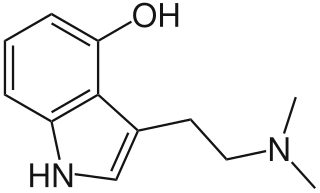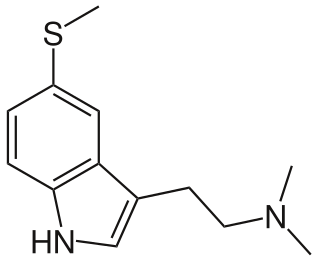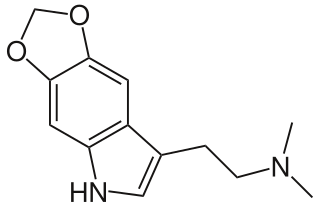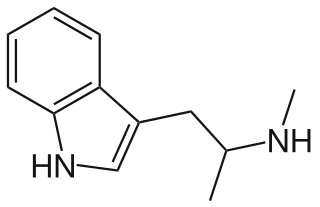
4-Hydroxy-N,N-diisopropyltryptamine is a synthetic psychedelic drug. It is a higher homologue of psilocin, 4-HO-DET, and is a positional isomer of 4-HO-DPT and has a tryptamine molecular sub-structure.

Psilocin is a substituted tryptamine alkaloid and a serotonergic psychedelic substance. It is present in most psychedelic mushrooms together with its phosphorylated counterpart psilocybin. Psilocin is a Schedule I drug under the Convention on Psychotropic Substances. Acting on the 5-HT2A receptors, psilocin modulates the production and reuptake of serotonin. The mind-altering effects of psilocin are highly variable and subjective and resemble those of LSD and DMT.

Diisopropyltryptamine is a psychedelic hallucinogenic drug of the tryptamine family that has a unique effect. While the majority of hallucinogens affect the visual sense, DiPT is primarily aural.

4-HO-DET, also known as 4-hydroxy-diethyl-tryptamine, CZ-74, is a hallucinogenic drug and psychedelic compound of moderate duration. 4-HO-DET is a substituted tryptamine, structurally related to psilocin, ethocybin, and 4-HO-DIPT.

5-MeO-MiPT is a psychedelic and hallucinogenic drug, used by some as an entheogen. It has structural and pharmacodynamic properties similar to the drugs 5-MeO-DiPT, DiPT, and MiPT. It is commonly used as a "substitute" for 5-MeO-DiPT because of the very similar structure and effects.

5-MeO-DET or 5-methoxy-N,N-diethyltryptamine is a hallucinogenic tryptamine.

4-HO-MiPT is a synthetic substituted aromatic compound and a lesser-known psychedelic tryptamine. It is thought to be a serotonergic psychedelic, similar to magic mushrooms, LSD and mescaline. Its molecular structure and pharmacological effects somewhat resemble those of the tryptamine psilocin, which is the primary psychoactive chemical in magic mushrooms.

5-MeO-DPT, is a psychedelic and entheogenic designer drug.

Ethylisopropyltryptamine (EiPT) is a chemical of the tryptamine family that and produces psychedelic and hallucinogenic effects. It was probably first synthesized by American psychopharmacologist, Alexander Shulgin.

2,N,N-trimethyltryptamine, 2,N,N-TMT, or 2-Me-DMT is a tryptamine derivative that is a psychedelic drug. It was invented by Alexander Shulgin and reported in his book TiHKAL (#34). It is claimed to show psychoactive effects at a dosage of 50–100 mg orally, but these are relatively mild compared to other similar drugs, suggesting that while the 2-methyl group has blocked the binding of metabolic enzymes, it is also interfering with binding to the 5HT2A receptor target that mediates the hallucinogenic effects of these drugs.

N,N-Dibutyltryptamine (DBT) is a psychedelic drug belonging to the tryptamine family. It is found either as its crystalline hydrochloride salt or as an oily or crystalline base. DBT was first synthesized by the chemist Alexander Shulgin and reported in his book TiHKAL . Shulgin did not test DBT himself, but reports a human dosage of "1 mg/kg i.m." being active, but less so than DMT or DET. This suggests that an active dosage of DBT will be in the 100 mg range. This compound has been sold as a "research chemical" and has been confirmed to be an active hallucinogen although somewhat weaker than other similar tryptamine derivatives. It produces a head-twitch response in mice.

4-HO-MET is a lesser-known psychedelic drug. It is a structural and functional analog of psilocin as well as the 4-hydroxyl analog of methylethyltryptamine (MET). 4-HO-MET was first synthesized by Alexander Shulgin. In his book TiHKAL, the dosage is listed as 10-20 mg. 4-HO-MET produces psilocin-like distortion of color, sound, and form. Very little data exists about the pharmacological properties, metabolism, and toxicity of 4-HO-MET. There have been no reports of deaths from 4-HO-MET, despite the existence of anecdotal reports of the ingestion of up to 150 mg, more than an order of magnitude above the effective dose.

4-Hydroxy-N-methyl-N-propyltryptamine, commonly known as 4-HO-MPT or meprocin, is a psychedelic drug in the tryptamine class of chemical compounds and is a higher homologue of the naturally occurring substituted tryptamine psilocin as well as being the 4-hydroxyl analog of MPT.

4-MeO-MiPT, or 4-methoxy-N-methyl-N-isopropyltryptamine, is a lesser-known psychedelic drug. It is the 4-methoxy analog of MiPT. 4-MeO-MiPT was first synthesized by Alexander Shulgin and is mentioned in his book TiHKAL. Subsequent testing by Shulgin on human test subjects showed the effective dose as 20-30 mg ; the onset time between ingestion and the first noticeable effects was 45-60 min, with sensations lasting between 2-2.5 hours. The sensation were significantly milder than those of 4-HO-MiPT, with 4-MeO-MiPT producing erotic-enhancing effects, and few of the visuals common with tryptamines. Very little data exists about the pharmacological properties, metabolism, and toxicity of 4-MeO-MiPT.

5-MeS-DMT (5-methylthio-N,N-dimethyltryptamine) is a lesser-known psychedelic drug. It is the 5-methylthio analog of dimethyltryptamine (DMT). 5-MeS-DMT was first synthesized by Alexander Shulgin. In his book TiHKAL, the minimum dosage is listed as 15-30 mg. The duration listed as very short, just like DMT. 5-MeS-DMT produces similar effects to DMT, but weaker. Shulgin describes his feelings while on a low dose of this drug as "pointlessly stoned", although at a higher dose of 20 mg he says it is "quite intense" and suggests that a higher dose still might have full activity.

5,6-MDO-DMT, or 5,6-methylenedioxy-N,N-dimethyltryptamine, is a lesser-known psychedelic drug. It is the 5,6-methylenedioxy analog of DMT. 5,6-MDO-DMT was first synthesized by Alexander Shulgin. In his book TiHKAL, 5,6-MDO-DMT produces no noticeable psychoactive effects, although it was only tested up to a dose of 5 mg. Very little data exists about the pharmacological properties, metabolism, and toxicity of 5,6-MDO-DMT.

5,6-MeO-MiPT, or 5,6-dimethoxy-N-methyl-N-isopropyltryptamine, is a lesser-known psychedelic drug. It is the 5,6-dimethoxy analog of MiPT. 5,6-MeO-MiPT was first synthesized by Alexander Shulgin. In his book TiHKAL, 5,6-MeO-MiPT produces no noticeable psychoactive effects. Very little data exists about the pharmacological properties, metabolism, and toxicity of 5,6-MeO-MiPT.

4,5-MDO-DiPT, or 4,5-methylenedioxy-N,N-diisopropyltryptamine, is a lesser-known psychedelic drug. It is the 4,5-methylenedioxy analog of DiPT. 4,5-MDO-DiPT was first synthesized by Alexander Shulgin. In his book TiHKAL, 4,5-MDO-DiPT produces slight LSD-like effects after several hours. Very little data exists about the pharmacological properties, metabolism, and toxicity of 4,5-MDO-DiPT.

Alpha,N-DMT, or α,N-dimethyltryptamine, is a lesser-known psychedelic drug. It is the α,N-dimethyl analog of DMT. α,N-DMT was first synthesized by Alexander Shulgin. In his book TiHKAL, Shulgin lists the dosage as 50-100 mg, and the duration as 6–8 hours. α,N-DMT causes an unpleasant body load. Very little data exists about the pharmacological properties, metabolism, and toxicity of α,N-DMT. α,N-DMT is known to be a potent monoamine oxidase inhibitor

4-Hydroxy-α-methyltryptamine (4-HO-αMT) is a psychedelic drug of the tryptamine class. It is a close structural analogue of α-methyltryptamine (αMT) and produces similar effects to it, but with exacerbated side effects similarly to 5-MeO-αMT. Alexander Shulgin describes 4-HO-αMT briefly in his book TiHKAL:
The 4-hydroxy analogue of αMT has been looked at in human subjects. It is reported to be markedly visual in its effects, with some subjects reporting dizziness and a depressed feeling. There were, however, several toxic signs at doses of 15 to 20 milligrams orally, including abdominal pain, tachycardia, increased blood pressure and, with several people, headache and diarrhea.





















